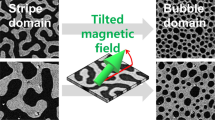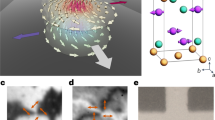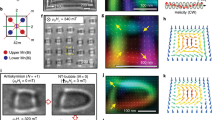Abstract
Magnetic skyrmions are compact chiral spin textures that exhibit a rich variety of topological phenomena and hold potential for the development of high-density memory devices and novel computing schemes driven by spin currents. Here, we demonstrate the room-temperature interfacial stabilization and current-driven control of skyrmion bubbles in the ferrimagnetic insulator Tm3Fe5O12 coupled to Pt, showing the current-induced motion of individual skyrmion bubbles. The ferrimagnetic order of the crystal together with the interplay of spin–orbit torques and pinning determine the skyrmion dynamics in Tm3Fe5O12 and result in a strong skyrmion Hall effect characterized by a negative deflection angle and hopping motion. Further, we show that the velocity and depinning threshold of the skyrmion bubbles can be modified by exchange coupling Tm3Fe5O12 to an in-plane magnetized Y3Fe5O12 layer, which distorts the spin texture of the skyrmions and leads to directional-dependent rectification of their dynamics. This effect, which is equivalent to a magnetic ratchet, is exploited to control the skyrmion flow in a racetrack-like device.
This is a preview of subscription content, access via your institution
Access options
Access Nature and 54 other Nature Portfolio journals
Get Nature+, our best-value online-access subscription
$29.99 / 30 days
cancel any time
Subscribe to this journal
Receive 12 print issues and online access
$259.00 per year
only $21.58 per issue
Buy this article
- Purchase on Springer Link
- Instant access to full article PDF
Prices may be subject to local taxes which are calculated during checkout






Similar content being viewed by others
Data availability
The data that support the findings of this study have been deposited in the Research Collection database of the ETH Zurich and are available from https://doi.org/10.3929/ethz-b-000542503.
References
Mühlbauer, S. et al. Skyrmion lattice in a chiral magnet. Science 323, 915–919 (2009).
Nagaosa, N. & Tokura, Y. Topological properties and dynamics of magnetic skyrmions. Nat. Nanotechnol. 8, 899–911 (2013).
Tokura, Y. & Kanazawa, N. Magnetic skyrmion materials. Chem. Rev. 121, 2857–2897 (2021).
Fert, A., Reyren, N. & Cros, V. Magnetic skyrmions: advances in physics and potential applications. Nat. Rev. Mater. 2, 17031 (2017).
Back, C. et al. The 2020 skyrmionics roadmap. J. Phys. D 53, 363001 (2020).
Jiang, W. et al. Blowing magnetic skyrmion bubbles. Science 349, 283–286 (2015).
Woo, S. et al. Observation of room-temperature magnetic skyrmions and their current-driven dynamics in ultrathin metallic ferromagnets. Nat. Mater. 15, 501–506 (2016).
Fert, A., Cros, V. & Sampaio, J. Skyrmions on the track. Nat. Nanotechnol. 8, 152–156 (2013).
Zázvorka, J. et al. Thermal skyrmion diffusion used in a reshuffler device. Nat. Nanotechnol. 14, 658–661 (2019).
Song, K. M. et al. Skyrmion-based artificial synapses for neuromorphic computing. Nat. Electron. 3, 148–155 (2020).
Chumak, A. V., Vasyuchka, V. I., Serga, A. A. & Hillebrands, B. Magnon spintronics. Nat. Phys. 11, 453–461 (2015).
Kajiwara, Y. et al. Transmission of electrical signals by spin-wave interconversion in a magnetic insulator. Nature 464, 262–266 (2010).
Lebrun, R. et al. Tunable long-distance spin transport in a crystalline antiferromagnetic iron oxide. Nature 561, 222–225 (2018).
Cornelissen, L. J. et al. Long-distance transport of magnon spin information in a magnetic insulator at room temperature. Nat. Phys. 11, 1022–1026 (2015).
Wimmer, T. et al. Spin transport in a magnetic insulator with zero effective damping. Phys. Rev. Lett. 123, 257201 (2019).
Avci, C. O. et al. Interface-driven chiral magnetism and current-driven domain walls in insulating magnetic garnets. Nat. Nanotechnol. 14, 561–566 (2019).
Vélez, S. et al. High-speed domain wall racetracks in a magnetic insulator. Nat. Commun. 10, 4750 (2019).
Ding, S. et al. Interfacial Dzyaloshinskii–Moriya interaction and chiral magnetic textures in a ferrimagnetic insulator. Phys. Rev. B 100, 100406 (2019).
Caretta, L. et al. Interfacial Dzyaloshinskii–Moriya interaction arising from rare-earth orbital magnetism in insulating magnetic oxides. Nat. Commun. 11, 1090 (2020).
Lee, A. J. et al. Probing the source of the interfacial Dzyaloshinskii–Moriya interaction responsible for the topological Hall effect in metal/Tm3Fe5O12 systems. Phys. Rev. Lett. 124, 107201 (2020).
Thiaville, A., Rohart, S., Jué, É., Cros, V. & Fert, A. Dynamics of Dzyaloshinskii domain walls in ultrathin magnetic films. Europhys. Lett. 100, 57002 (2012).
Emori, S., Bauer, U., Ahn, S.-M. M., Martinez, E. & Beach, G. S. D. D. Current-driven dynamics of chiral ferromagnetic domain walls. Nat. Mater. 12, 611–616 (2013).
Ryu, K. S., Thomas, L., Yang, S. H. & Parkin, S. Chiral spin torque at magnetic domain walls. Nat. Nanotechnol. 8, 527–533 (2013).
Manchon, A. et al. Current-induced spin-orbit torques in ferromagnetic and antiferromagnetic systems. Rev. Mod. Phys. 91, 035004 (2019).
Lee, A. J. et al. Investigation of the role of rare-earth elements in spin-Hall topological Hall effect in Pt/ferrimagnetic-garnet bilayers. Nano Lett. 20, 4667–4672 (2020).
Shao, Q. et al. Topological Hall effect at above room temperature in heterostructures composed of a magnetic insulator and a heavy metal. Nat. Electron. 2, 182–186 (2019).
Ahmed, A. S. S. et al. Spin-Hall topological Hall effect in highly tunable Pt/ferrimagnetic-insulator bilayers. Nano Lett. 19, 5683–5688 (2019).
Hubert, A. & Schäfer, R. Magnetic Domains: The Analysis of Magnetic Microstructures (Springer, 1998).
Soumyanarayanan, A. et al. Tunable room-temperature magnetic skyrmions in Ir/Fe/Co/Pt multilayers. Nat. Mater. 16, 898–904 (2017).
Büttner, F., Lemesh, I. & Beach, G. S. D. Theory of isolated magnetic skyrmions: from fundamentals to room temperature applications. Sci. Rep. 8, 4464 (2018).
Avci, C. O. et al. Current-induced switching in a magnetic insulator. Nat. Mater. 16, 309–314 (2017).
Li, H., Akosa, C. A., Yan, P., Wang, Y. & Cheng, Z. Stabilization of skyrmions in a nanodisk without an external magnetic field. Phys. Rev. Appl. 13, 034046 (2020).
Jiang, W. et al. Direct observation of the skyrmion Hall effect. Nat. Phys. 13, 162–169 (2017).
Litzius, K. et al. Skyrmion Hall effect revealed by direct time-resolved X-ray microscopy. Nat. Phys. 13, 170–175 (2017).
Hirata, Y. et al. Vanishing skyrmion Hall effect at the angular momentum compensation temperature of a ferrimagnet. Nat. Nanotechnol. 14, 232–236 (2019).
Woo, S. et al. Current-driven dynamics and inhibition of the skyrmion Hall effect of ferrimagnetic skyrmions in GdFeCo films. Nat. Commun. 9, 959 (2018).
Crossley, S. et al. Ferromagnetic resonance of perpendicularly magnetized Tm3Fe5O12/Pt heterostructures. Appl. Phys. Lett. 115, 172402 (2019).
Juge, R. et al. Current-driven skyrmion dynamics and drive-dependent skyrmion Hall effect in an ultrathin film. Phys. Rev. Appl. 12, 044007 (2019).
Reichhardt, C., Ray, D. & Reichhardt, C. J. O. Collective transport properties of driven skyrmions with random disorder. Phys. Rev. Lett. 114, 217202 (2015).
Zeissler, K. et al. Diameter-independent skyrmion Hall angle observed in chiral magnetic multilayers. Nat. Commun. 11, 428 (2020).
Litzius, K. et al. The role of temperature and drive current in skyrmion dynamics. Nat. Electron. 3, 30–36 (2020).
Kim, J.-V. & Yoo, M.-W. Current-driven skyrmion dynamics in disordered films. Appl. Phys. Lett. 110, 132404 (2017).
Legrand, W. et al. Room-temperature current-induced generation and motion of sub-100 nm skyrmions. Nano Lett. 17, 2703–2712 (2017).
Woo, S. et al. Deterministic creation and deletion of a single magnetic skyrmion observed by direct time-resolved X-ray microscopy. Nat. Electron. 1, 288–296 (2018).
Hrabec, A. et al. Current-induced skyrmion generation and dynamics in symmetric bilayers. Nat. Commun. 8, 15765 (2017).
Torrejon, J., Martinez, E. & Hayashi, M. Tunable inertia of chiral magnetic domain walls. Nat. Commun. 7, 13533 (2016).
Zang, J., Cros, V. & Hoffmann, A. in Topology in Magnetism Ch. 2 (Springer, 2019).
Baumgartner, M. & Gambardella, P. Asymmetric velocity and tilt angle of domain walls induced by spin-orbit torques. Appl. Phys. Lett. 113, 242402 (2018).
Caretta, L. et al. Fast current-driven domain walls and small skyrmions in a compensated ferrimagnet. Nat. Nanotechnol. 13, 1154–1160 (2018).
Kubota, M. et al. Systematic control of stress-induced anisotropy in pseudomorphic iron garnet thin films. J. Magn. Magn. Mater. 339, 63–70 (2013).
Schindelin, J. et al. Fiji: an open-source platform for biological-image analysis. Nat. Methods 9, 676–682 (2012).
Tetienne, J. P.-P. et al. The nature of domain walls in ultrathin ferromagnets revealed by scanning nanomagnetometry. Nat. Commun. 6, 6733 (2015).
Dovzhenko, Y. et al. Magnetostatic twists in room-temperature skyrmions explored by nitrogen-vacancy center spin texture reconstruction. Nat. Commun. 9, 2712 (2018).
Gross, I. et al. Skyrmion morphology in ultrathin magnetic films. Phys. Rev. Mater. 2, 024406 (2018).
Gruber, A. et al. Scanning confocal optical microscopy and magnetic resonance on single defect centers. Science 276, 2012–2014 (1997).
Wangsness, R. K. Sublattice effects in magnetic resonance. Phys. Rev. 91, 1085–1091 (1953).
Collet, M. et al. Generation of coherent spin-wave modes in yttrium iron garnet microdiscs by spin–orbit torque. Nat. Commun. 7, 10377 (2016).
Paulevé, J. Ferromagnetic resonance of gadolinium garnet at 9300 МC/S. C. R. Acad. Sci. 244, 1908–1910 (1957).
Ding, S. et al. Identifying the origin of the nonmonotonic thickness dependence of spin-orbit torque and interfacial Dzyaloshinskii–Moriya interaction in a ferrimagnetic insulator heterostructure. Phys. Rev. B 102, 054425 (2020).
Acknowledgements
We acknowledge A. Thiaville, A. Hrabec and C. Moutafis for useful discussions and M. Müller for technical assistance with the MOKE set-up. This work was funded by the Swiss National Science Foundation (grant nos. 200020-200465 (P.G.), 200021-188414 (M.T.), 200021-178825 (M.F.), PZ00P2-179944 (B.J.J.) and 200020-175600 (C.L.D.)), the European Research Council (Advanced Grant 694955-INSEETO (M.F.)) and ETH Zürich (Career Seed Grant SEED-20 19-2 (S.V.)). S.R.-G. acknowledges support from the Spanish Ministry of Economy and Competitiveness (FPI fellowship and grant no. RTI2018-095303-B-C53). S.V. acknowledges financial support by the Ministry of Science, Innovation and Universities through the Maria de Maeztu Program for Units of Excellence in R&D (grant no. CEX2018-000805-M) and the Comunidad de Madrid through the Atracción de Talento program (grant no. 2020-T1/IND-20041).
Author information
Authors and Affiliations
Contributions
S.V. conceived the study and coordinated the experimental work. J.S., E.G. and M.T. grew and characterized the films. S.V. fabricated the devices. S.V. and S.R.-G. performed the transport and MOKE experiments and analysed the data. B.J.J. assisted with the time-resolved transport measurements. M.S.W. and P.W. performed the NV measurements with the help of S.V. S.V. and P.G. wrote the manuscript. P.G., M.T., C.L.D. and M.F. supervised the work. All authors contributed to the scientific discussion and manuscript revisions.
Corresponding authors
Ethics declarations
Competing interests
The authors declare no competing interests.
Peer review
Peer review information
Nature Nanotechnology thanks the anonymous reviewers for their contribution to the peer review of this work.
Additional information
Publisher’s note Springer Nature remains neutral with regard to jurisdictional claims in published maps and institutional affiliations.
Extended data
Extended Data Fig. 1 Skyrmion bubble radius.
a, Differential MOKE image of a representative Q = +1 skyrmion bubble for \(H_z = - 20\) Oe. The white (dark) contrast indicates regions with m of TmIG pointing up (down). Scale bar, 1 μm. b, Line profile of the MOKE intensity taken along the red dashed line in a (red solid line) together with its fitting (light grey) assuming that the skyrmion is a square box function having an ellipsoidal shape convoluted by a Gaussian function with standard deviation ~300 nm, which represents the spatial resolution of the MOKE set up49. The domain wall width, which is \({{\Delta }}_{{{{\mathrm{DW}}}}}\sim 60\) nm (Fig. 2), is neglected in the fitting procedure. The main diameters a and b of the skyrmion bubble are extracted by fitting the two orthogonal axes of the ellipsoid. From the fit in b we estimate \(a\sim 1.2\) μm. c, Skyrmion bubble radius R as a function of \(H_z\). The radius is estimated as \(R = (a + b)/4\). Each data point corresponds to the average value obtained from fitting over 10 independent skyrmion bubbles with circular shape (\(b/a \gtrsim 0.9\)). The error bars represent the standard deviation of the measurements. See Supplementary Note 6 for discussion on the field dependence of the skyrmion bubble radius and bubble stabilization with \(H_z\).
Extended Data Fig. 2 Skyrmion ellipticity and orientation.
a, Statistical analysis of the skyrmion ellipticity b/a from fitting over 1000 skyrmion bubbles assuming an ellipsoidal shape (see schematic). The histograms are extracted from analyzing the MOKE images of the bubble trajectories presented in Fig. 4a. b, Analysis of the orientation of the skyrmion ellipsoids from the data in a. The angle β defines the orientation of the longest axis of the ellipsoid with respect to the current (see schematic).
Extended Data Fig. 3 Jx−tp threshold conditions for skyrmion depinning (blue circles), heat dominated motion (red triangles), and random nucleation and annihilation of skyrmion bubbles in TmIG (black squares).
\(|H_z| = 20\) Oe and the YIG layer is demagnetized. No difference was observed between \(Q = + 1\) and \(- 1\) skyrmion bubbles. Supplementary Note 9 presents the current threshold for skyrmion depinning in the presence of \({{{\mathbf{H}}}}_y\), that is, with \({{{\mathbf{M}}}}_{{{{\mathrm{YIG}}}}}\) controlled with an in-plane magnetic field. All measurements of the skyrmion dynamics presented in this work were performed for \(t_{{{\mathrm{p}}}},\left| {J_x} \right|\) conditions comprised between the curves defined by the blue circles and the red triangles. Above the threshold defined by the red triangles, the mean displacements \(\overline {\Delta x} ,\overline {\Delta y}\) abruptly drop, indicating that the skyrmion dynamics are dominated by Joule heating induced random skyrmion motion rather than by SOTs. We attribute this behavior to the exponential increase of the skyrmion diffusivity with temperature, which is expected in materials with low disorder and low damping such as TmIG9.
Extended Data Fig. 4 Current-induced temperature increase.
a, Schematic of the experimental setup. The voltage output of the pulse generator is applied through the device and both the voltage drop at the device and the pulse are monitored with an Oscilloscope with an internal impedance of 50 Ω. From these measurements, we can precisely determine the evolution of the sample resistance during the current pulse. b, Increase of the sample resistance during the application of a current pulse \(t_{{{\mathrm{p}}}} = 100\) ns (left axis). The pulse starts at time 0 ns. The colour indicates different set currents computed from the base resistance of the device \(R_0(295\;{{{\mathrm{K}}}}) = 1130\) Ω. The right axis shows the increase of temperature calculated from calibration measurements. We estimate the threshold for heat dominated motion for temperature increases of about 20 K.
Extended Data Fig. 5 Mean \(\overline {\Delta {{{\mathbf{x}}}}}\) and \(\overline {\Delta {{{\mathbf{y}}}}}\) displacements for YIG demagnetized.
a, b, Average bubble displacements per pulse \(\overline {\Delta x}\) and \(\overline {\Delta y}\) as a function of \(t_{{{\mathrm{p}}}}\) computed considering all pulse events, that is, including those that did not lead to bubble displacements. \(\overline {\Delta x}\) and \(\overline {\Delta y}\) increase linearly with the pulse length, exhibiting a finite value as \(t_{{{\mathrm{p}}}} \to 0\). The difference between \(\overline {\Delta x}\),\(\overline {\Delta y}\) and \(x_0,y_0\) (Fig. 4c,d) arises from the decrease of the bubble depinning probability when decreasing \(t_{{{\mathrm{p}}}}\). Different symbols indicate different current densities. \(H_z = - 20\) Oe (\(Q = + 1\)). YIG is demagnetized.
Extended Data Fig. 6 Pulse length dependence of \({{{\boldsymbol{x}}}}_0,{{{\boldsymbol{y}}}}_0\) with \({{{\mathbf{M}}}}_{{{{\mathbf{YIG}}}}}\) along \(- {{{\mathbf{y}}}}\).
a, b, Mean displacement values \(x_0,y_0\) extracted from the trajectory of several skyrmion bubbles with \({{{\mathbf{M}}}}_{{{{\mathrm{YIG}}}}}\) along \(- {{{\mathbf{y}}}}\) (see Fig. 4a,b for details regarding the analysis). Data taken for \(H_z = - 20\) Oe (\(Q = + 1\)) and for both polarities of \({{{\mathbf{J}}}}_x\) (indicated by an arrow). The sign of \(x_0,y_0\) corresponds to the sign of \({{{\mathbf{J}}}}_x.\) Different colours indicate the current density. The error bars are the standard errors of \(x_0\), \(y_0\) calculated from the variance of these magnitudes to the double Gaussian distribution of \(\delta x,\delta y\). As for the case of YIG demagnetized (Fig. 4c,d), \(x_0\) and \(y_0\) tend to finite values when \(t_{{{\mathrm{p}}}} \to 0\). Remarkably, the \(x_0,y_0(t_{{{\mathrm{p}}}} \to 0)\) values are similar for both directions of \({{{\mathbf{J}}}}_{{{\mathrm{x}}}}\) and similar to the ones measured for YIG demagnetized. As \(t_{{{\mathrm{p}}}}\) increases, \(x_0\) and \(y_0\) start to increase from a pulse length threshold value that depends on the amplitude of the current. Larger (smaller) current densities are required for driving skyrmion bubbles with \({{{\mathbf{M}}}}_{{{{\mathrm{YIG}}}}}\) pointing to \(- {{{\boldsymbol{y}}}}\) and \(J_{{{\mathrm{x}}}} < 0\) (\(J_{{{\mathrm{x}}}} > 0\)), which is in agreement with the ratchet effect reported in Figs. 5 and 6 and Supplementary Note 10. c, Velocity of the skyrmion bubbles computed as \(\left| {v_0} \right| = \sqrt {x_0^2 + y_0^2} /t_{{{\mathrm{p}}}}\) from the data shown in a and b. The sign of the velocity is defined by the sign of \(x_0\); the error bars are computed by error propagation. As observed for the mean bubble velocity \(\bar v_{{{{\mathrm{sk}}}}}\) for YIG demagnetized (Fig. 4e), \(v_0\) increase as \(t_{{{\mathrm{p}}}}\) reduces (note that \(v_0(t_{{{\mathrm{p}}}})\) exhibits a stepper increase than \(\bar v_{{{{\mathrm{sk}}}}}(t_{{{\mathrm{p}}}})\) when reducing tp).
Extended Data Fig. 7 Skyrmion trajectories with MYIG collinear to Jx.
a, Skyrmion trajectories with Q=−1 and YIG demagnetized (see inset’s schematic). Data taken in a different device from the same YIG/TmIG/Pt heterostructure. Hz=+20 Oe, \(J_x = 3.5 \times 10^{11}\) A m−2, and tp=20 ns. The measurement protocol is the same employed in Fig. 4a. b, c, Skyrmion trajectories for MYIG pointing to +x and −x, respectively. \(\left| {H_x} \right| = 10\) Oe. In contrast to the difference observed between MYIG parallel to +y and −y (Figs. 5a and b), the skyrmion dynamics for MYIG collinear with the current is, within the error, independent on the direction of MYIG. No clear differences between \({{{\mathbf{M}}}}_{{{{\mathrm{YIG}}}}}\parallel \pm {{{\mathbf{x}}}}\) (b,c) and the demagnetized case (a) can be identified either.
Supplementary information
Supplementary Information
Supplementary Notes 1–10, Figs. 1–11 and Table 1.
Rights and permissions
About this article
Cite this article
Vélez, S., Ruiz-Gómez, S., Schaab, J. et al. Current-driven dynamics and ratchet effect of skyrmion bubbles in a ferrimagnetic insulator. Nat. Nanotechnol. 17, 834–841 (2022). https://doi.org/10.1038/s41565-022-01144-x
Received:
Accepted:
Published:
Issue Date:
DOI: https://doi.org/10.1038/s41565-022-01144-x
This article is cited by
-
Acoustic-driven magnetic skyrmion motion
Nature Communications (2024)
-
Magnetoresistive detection of perpendicular switching in a magnetic insulator
Communications Physics (2024)
-
magnum.np: a PyTorch based GPU enhanced finite difference micromagnetic simulation framework for high level development and inverse design
Scientific Reports (2023)
-
Reversible conversion between skyrmions and skyrmioniums
Nature Communications (2023)
-
Ultra-thin lithium aluminate spinel ferrite films with perpendicular magnetic anisotropy and low damping
Nature Communications (2023)



